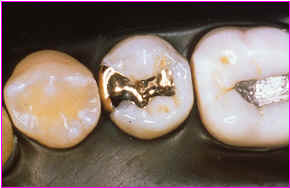
Black's Principles of Cavity Preparation

When a dentist uses a drill to prepare a tooth to receive a filling, certain principles of design are followed in a particular order. In total, there are seven principles that were developed by GV Black (see link above). Two of Black’s seven principles of cavity design are particularly dependent upon which filling material will be used to restore the tooth (amalgam, composite or cast gold). These two materials-dependent principles are:
Resistance Form – the design features of the preparation that guards against future fracture of both the restoration and the tooth
Retention Form – simply put, the shape that is responsible for retaining the filling (keeping the filling from falling out).
The five remaining principles of cavity preparation deal with the overall shape of the preparation, operator access, caries removal, preparation refinement, and cleanliness and will be addressed at another time.
Dental Materials Properties Review

Composite Tooth colored fillings that are placed during a single dental appointment are called dental composites. Composite is a resin-based material and actually bonds to tooth structure (the bond is stronger to enamel than it is to dentin). Composite material is soft when first applied to a tooth preparation and then undergoes a light curing process which hardens the material.
Amalgam Silver fillings are a combination of metals held together by mercury. There is no bonding that occurs between amalgam and the surface of the tooth. In increments less than 2 mm, amalgam is brittle when biting forces are applied. However, with adequate thickness, amalgam can withstand the same biting forces as natural teeth. Dental amalgam is soft when first condensed into a tooth preparation and then hardens within a few minutes.

Cast Gold Gold fillings and crowns are a combination of gold and other metals that produce mechanical properties very similar to natural tooth structure. Unlike amalgam, gold can withstand being drawn to extremely thin increments (such as gold foil), and is maleable, making it extremely adaptable along the enamel-gold margin. Cast gold restorations are made in the lab from an impression of the tooth preparation. The lost wax technique is used to fabricate a gold filling that will later be cemented to the tooth preparation using a dental cement.
Exploration Phase I
Based on your understanding of some of the dental materials properties for composite, amalgam, and cast gold restorations, let's explore the design elements for the Resistance and Retention forms for each type of tooth preparation.
Question #1
For a composite restoration, there a very few rules of preparation design that are needed for successful resistance and retention form for this type of restoration. What material property do you suppose is responsible for achieving this adequate resistance and retention?
Question #2
For an amalgam restoration, estimate how deep the preparation should be and why? Which principle of cavity design will this satisfy?
Question #3
For an amalgam restoration, what design feature(s) will be responsible for retaining the restoration?
Question #4
How will the relationship of the internal walls of a cast gold restoration, differ from that of an amalgam restoration? Why?
Exploration Phase II
Now, you will have a chance to draw some tooth preparations. When you click on the Tooth Drawing link below, you will see a side view of a tooth that already contains an amalgam preparation. Note the orientation of the walls (they converge toward the occlusal surface). Complete the following activities:
Activity #1
Select a color with which to draw a side view of a cast gold preparation. Superimpose your image on the existing amalgam preparation. Note the change in orientation of the internal walls.
Activity #2
Select a different color with which to draw a side view of a composite preparation.
To Erase: If at any time you need to erase your drawing, click the Refresh button and start again.
Exploration Phase III
1. Evaluate the plastic model of the premolar tooth preparation and answer the following questions:
Question #1 - 4
1. Where do you think the decay was located on this tooth prior to preparation?
2. How deep do you estimate the filling to be?
3. What is the relationship of the internal walls? Do they converge or diverge toward the occlusal surface?
4. What do you think is the function of the "dovetail" feature on the occlusal surface?
Question #5
Based on your answers to questions 2 - 4, what type of preparation is this?
2. Evaluate the plastic model of the molar tooth preparation and answer the following questions:
Question #6
List as many similarities and differences that you can between the premolar and the molar preparations:
Question #7 What type of preparation is this?
3. Evaluate the plastic model of the incisor tooth preparations (there are two).
Question #8 What type of preparation are these?
Concept Introduction